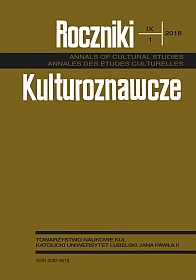Casino Royale: Between Novel and Film Adaptation
Abstract
James Bond was created by Ian Fleming on the pages of Casino Royale, a 1962 spy thriller, who since has been adapted in various media: film, television, radio, comics and computer games. However the 2006 Casino Royale film adaptation stands out, because, as a reboot of the series, it balances between honoring the literary original and staying true to the James Bond film formula, at the same time reinvigorating and refreshing the whole franchise for a new movie-going audience. The Author of this article aims at answering the question: what does it really mean that James Bond is going back to its roots? As a result, the real redefinition of the James Bond paradigm can be seen on a structural level in reference to mechanism of tension building. Suspense may be seen as a key to adapting Casino Royale, which opens up modifications in the way the protagonist and the antagonist are characterized, as well as making the narrative conflicts and stakes more real and meaningful.
References
ALBION, Alexis. „Wanting to be James Bond”. W: Ian Fleming and James Bond: The Cultural Politics of 007, red. Edward P. Comentale, Stephen Watt i Skip Willman, 202–221. Indianapolis: Indiana University Press, 2005.
ATTOLINO, Paola. „Licence to Adapt: the Resilience of the 007 Narration in Casino Royale”. Testi e Linguaggi 7 (2013): 139–148.
ARNETT, Robert. „Casino Royale and Franchise Remix: James Bond as Superhero Film Criticism”. Ann Arbor, MI33.3. Wiosna 2009.
BENNETT, Tony, i Janet WOOLLACOTT. Bond and Beyond: The Political Career of a Popular Hero. London: Macmillan, 1987.
BLACK, Jeremy. The Politics of James Bond: From Ian Fleming’s novels to the big screen. London: Praeger Publishers, 2001.
CHAPMAN, James. Licence to thrill: The cultural history of the James Bond Films. London: I.B. Tauris, 2007.
COOPER, Holly, Sharon SCHEMBRI i Dale MILLER. “Brand self-identity narratives in the James Bond movies”, Psychology and Marketing, 27 (2010), 6: 557–567. DOI: 10.1002/mar.20344.
DĄBAŁA, Jacek. Tajemnica i suspens w sztuce pisania: W kręgu retoryki dziennikarskiej i dramaturgii medialnej. Toruń: Adam Marszałek, 2010.
ECO, Umberto. Superman w literaturze masowej. Tłum. Joanna Ugniewska. Warszawa: PIW, 1996.
ELLESTROM, Lars. „Adaptation within the field of media transformation”. W: Adaptation Studies: New Challenges, New Directions. Red. Jorgen Bruhn, Anne Gjelsvik i Eirik Frisvold Hanssen, 117–132. London: Bloomsbury Publishing, 2013.
HENDRYKOWSKI, Marek. „Suspense”. W: Słownik terminów filmowych, red. Marek Hendrykowski, 286. Poznań: Ars Nova, 1994.
HENDRYKOWSKI, Marek. Współczesna adaptacja filmowa. Poznań: Wydawnictwo Naukowe UAM, 2014.
LEITCH, Thomas. Film Adaptation and its Discontents: From Gone with the Wind to The Passion of the Christ. Baltimore: The John Hopkins University Press, 2007.
MAIBAUM, Richard. „James Bond’s 39 bumps”. New York Times (1964). Archives. Dostęp 26.12.2017. http://www.nytimes.com/1964/12/13/james-bonds-39-bumps.html
MORRELL, Jessica. Between the Lines: Master the Subtle Elements of Fiction Writing. Cincinnati: Rider’s Digest Books, 2002.
ORTONY, Andrew, Gerald L. CLORE, i Allan COLLINS. The Cognitive Structure of Emotions. Cambridge: Cambridge University Press, 1990.
PROCTOR, William. „Regeneration & Rebirth: Anatomy of the Franchise Reboot”. Scope: An Online Journal of Film & TV Studies, 22 (2012). Dostęp: 27.12.2017. http://www.scope.nottingham.ac.uk/February_2012/proctor.pdf
PRZYTUŁA, Piotr. „Kultywacja czy dekonstrukcja mitu? Zmiany w paradygmacie bondowskim w kontekście trzech najnowszych części serii (Casino Royale, Quantum of Solace, Skyfall)”. Media — Kultura — Komunikacja Społeczna 9 (2013): 142–153.
Revisioning 007: James Bond and Casino Royale, red. Christoph Lindner. London: Wallflower Press, 2009.
SCHEIBEL, Will. „The History of Casino Royale on (and off) the screen”. W: Revisioning 007: James Bond and Casino Royale, red. Christoph Lindner, 11–32. London: Wallflower Press, 2009.
SMUTS, Aaron. „The Desire-Frustration Theory of Suspense”. The Journal of Aesthetics and Art Criticism, 66 (2008), 3: 281–290. JSTOR. Dostęp: 27.12.2017. www.jstor.org/stable/40206345.
SUTHERLAND, John. Fiction and the Fiction Industry. London: The Athlone Press, 1978.
WAGNER, Geoffrey. The Novel and the Cinema. Rutherford: Fairleigh Dickson University Press, 1975.





